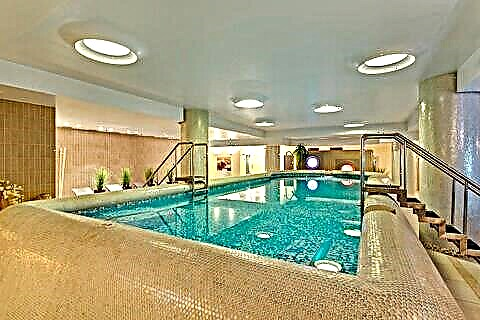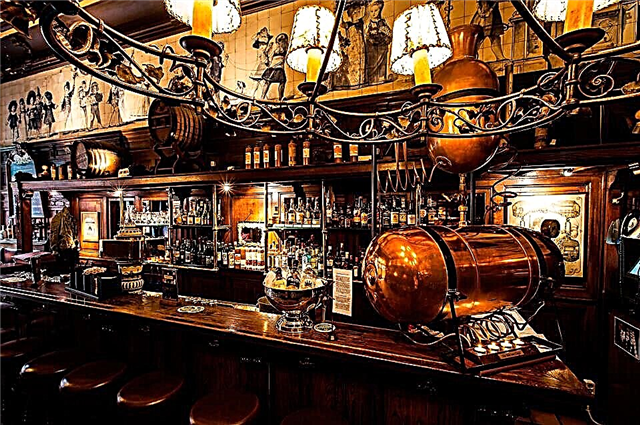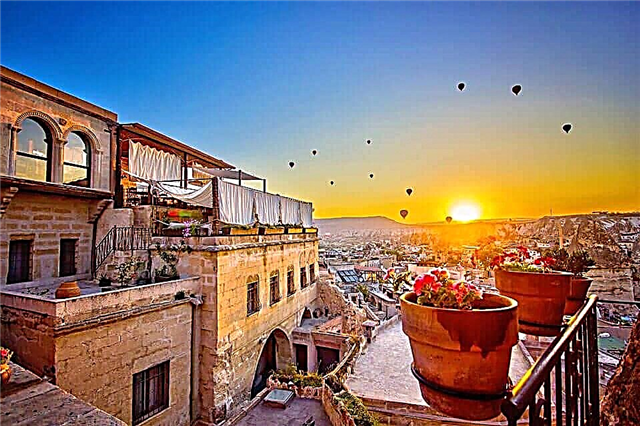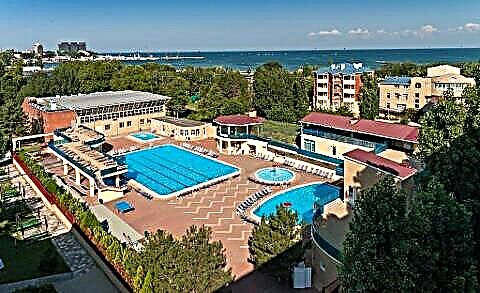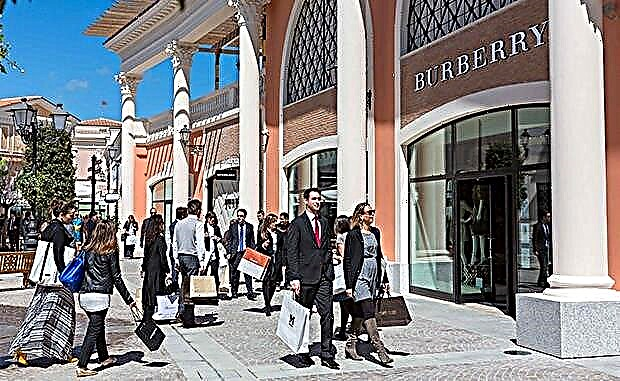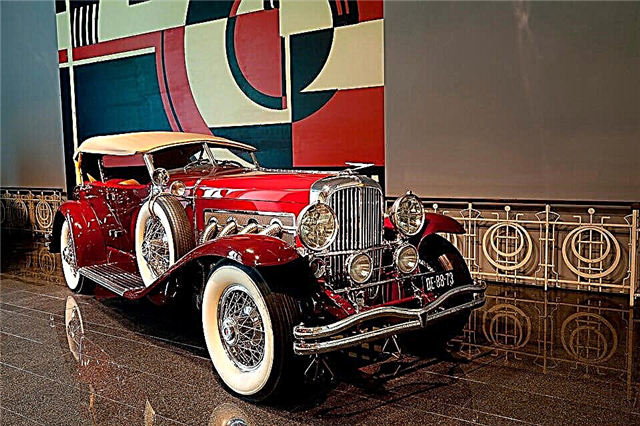The city of two royal residences, the seat of parliament and the seat of the UN court has its own unique flavor. Traditions are respected here and life flows steadily. There is no ultra-modern art here, and the main attractions of The Hague are majestic castles, landscaped parks and preserved medieval buildings. We will tell you where to go for a tourist and what to see in the first place, and we will help you draw up the best route for walking around this amazing city.
Peace palace

In the center of The Hague, in the middle of the park, there is the Peace Palace, which is the official residence of the International Court of Justice of the United Nations. The building of red brick and white sandstone, combining the Gothic, Romanesque and Byzantine styles, became a copy of the 17th century Town Hall. in Calais. It was built according to an adapted project of the French architect Cordonier, whose sketch won a competition among 216 other works, funded by the American philanthropist Carnegie. The palace is adorned with two towers, one of which houses a clock and a carillon with 48 bells.
The palace interior is impressive, which has absorbed the best from the countries of the world. There are Italian marble, Scandinavian wood, Chinese and Hungarian vases, American statues, Turkish and Persian carpets, Japanese tapestries. On the territory surrounding the palace, in front of which there is a fountain, there is a landscaped garden - the work of Thomas Mawson. You can visit the palace and garden only as part of a group for 9.5 € several times a year on weekends. The rest of the time, tourists will find a free audio guide and video tour at the Visitor Center, which is open from 10.00 to 17.00 daily, except Mondays.
Knight's hall

The Knights' Hall is located in the center of the Binnenhof palace complex and is part of it. Built in the XIII century. the building is used as before for special events. Previously, these were festivities, now the monarch's performances and royal receptions. The structure is a pointed pentahedron, which is surrounded by towers on both sides. The width of the walls of the building reaches 1.5 m. The facade is decorated with a round window with stained-glass windows depicting the coats of arms of the ruling monarchies.
The interior arrangement of the hall is also interesting. There are no usual columns or other structures supporting the roof. A fairly large span of 18 m is supported by a timber frame, reminiscent of an inverted ship's hull. In the room there is a throne and flags of 12 provinces. The unique building can only be visited on a group tour.
Binnenhof castle

Binnenhof Castle is a magnificent architectural complex in the heart of The Hague. Growing out of the count's hunting castle, today it is the focus of the country's political life, because the parliament and the government work within its walls. The complex consists of many buildings. The most interesting of them will be the Knights' Hall (the parliament was sitting in the adjacent wing before the move) and the Torentier Tower, where the Prime Minister was housed. In addition, the Binnenhof includes the buildings of the two chambers and the new parliament building.
The courtyard of the palace can be accessed through the Grenadier and Regency gates. Here the eye is drawn to a gilded wrought-iron fountain and a small church adorned with turrets. On 3 sides, the palace complex is surrounded by a magnificent park where you can walk and enjoy the views. On the fourth side, he goes to the Hoffeyver pond - this is how he appears to tourists in the photo.
Lowmann Automobile Museum

Even non-motorists will be interested in the Lowmann Museum. It presents the oldest private collection in the world, the first car in which appeared in 1934. Two generations of the Lowmanns have assembled cars, and during this time their number has exceeded 250 copies. The exposition includes both old and modern models. The museum moved several times. The last time in The Hague was in 2010, where he occupied a building specially built for him.
Here at 10 thousand meters2 visitors will find the unique Eisink, the Bikkers steam locomotive, the classic Spikers, the first Doji, Winston Churchill's Aston Martin, the rare Edsel-Peyser, the Amfikar amphibian and many others. The museum building has a restaurant and a shop where you can buy books and posters as well as Millers Oil products. The museum is open daily, except Mondays, from 10.00 to 17.00.
Miniature Park Madurodam

The miniature park embodies a typical Dutch city. This is not a copy of a certain city, it is a collective image. Here you can see views of Amsterdam, The Hague, Kinderdijk, Utrecht, Rotterdam. The park was created to support a sanatorium for students with tuberculosis so that they can continue their studies during treatment. The first contribution was given by the Madurodam family, which was the reason for the name of the project.
The project turned out to be very large-scale. The park, opened in 1952, was constantly being improved, and in 2011 it underwent renewal. The park's exhibits are made in a ratio of 1:25. The exposition is divided into several thematic zones. One of them is the "Grand Cities", which introduces such famous buildings as the Westerkerk Church, the Anne Frank Museum, the Royal Palace, the Tower House, etc. The peculiarity of the miniature park is its interactivity. Visitors can control figures, cars, trains, planes and even act out entire scenes.
Madurodam is open from 8.00 to 20.00 daily.
Mauritshuis Royal Gallery

The royal gallery Mauritshuis is located in the very center near Binnenhof in the mansion of the famous architect Jacob van Kampen. Opened in 1822, the gallery is one of the most famous in the Netherlands. The 16 rooms of the historic building house the relatively small Mauritshuis collection, which consists of 250 works by Dutch artists from the Golden Age. In addition, the exhibition includes paintings from other periods, miniatures, sculptures, drawings, etc. The halls themselves are also of interest due to the historical interiors created by painted ceilings, silk-lined walls and elegant chandeliers.
The gallery's collection includes works by Rembrandt, Vermeer, Potter, Wall, Fabricius, Hals and others. The gallery is connected by an underground passage to the Royal Wing, which houses workshops, a library and several rooms that can be rented. The museum has a brasserie and a gift shop. The gallery is open from 10.00 to 18.00, Monday 13.00-18.00.
Escher Museum

The Escher Museum is the best opportunity to get acquainted with the work of one of the best graphic artists of the 20th century. Moritz Escher. The museum opened in 2002 at Longue Voorhout Castle, which was previously used by the royal dynasties as a winter residence and office. Some of the buildings in the building still retain their historic interior. The recognized landmarks of the palace are the chandeliers of the famous sculptor Hans van Bentham and the Judd parquet floor.
The permanent exhibition includes lithographs, prints, wood carvings. The first floor houses the early works of the Dutch artist. Here "samples of the pen" are exhibited, from landscapes to graphics. The second floor was occupied by works of the late period, including world masterpieces: Belvedere, Air and Water, Waterfall and before. On the third floor there is a world of optical illusions, where visitors are so fond of taking pictures. The building houses a souvenir shop and cafe, which occupied the former kitchen of Queen Emma.
Pier Scheveningen

On the territory of Scheveningen, which is considered the best resort in the Netherlands, there is a pier with the same name. This is the second pier built here. The first one, built in 1901, was destroyed during the Second World War. was used by the Germans as an ammunition depot. In 1959, construction began on a 380-meter modern pier - a favorite with tourists and locals.It consists of two tiers: a glass lower gallery and an open upper one. The pier has become not only a promenade, an observation deck, but also a shopping and entertainment space.
On its territory there are numerous shops, cafes, bars, restaurants and even a casino. For lovers of a healthy lifestyle, personal training in the modern gym or relaxation in the seawater pools are offered. As entertainment, the pier can offer to look at the surroundings from the booth of the Ferris Wheel attraction, in which the air conditioner is installed. In search of adrenaline, they usually go to a 65-meter tower from which you can make a bungee jump.
Noordeinde Palace

One of the 4 official residences of the royal family, the Noordeinde Palace is located in the heart of the shopping street. Built as a farmhouse, Noordeinde is distinguished by its modesty. The original stonework is still intact in its basements. The appearance of the palace is associated with the name of Frederick Heinrich, the grandson of William of Orange, on whose orders in 1609 an ordinary house began to be expanded and rebuilt. Over the centuries, it passed from hand to hand, until in 1813 the palace became the property of the state and the official winter residence of the royal family.
Someone liked it, some did not, someone was born here, and someone did not live a day in it. In 1984, the title of royal office was established for Noordijnde, which it remains to this day. Since 2013, the King of the Netherlands Willem Alexander has been working there. Due to the small size of the building and the occupation of the monarch, the palace remains closed to the public. For several weeks in summer, it is open for excursions.
Huis ten Bose palace

Another official residence of the royal dynasty is located in the middle of the magnificent park of The Hague-Bose. The Heist-ten-Bose palace, which is not at all like the ordinary Nordeinde, is striking in its magnificence. From the building itself to the landscape design, it is more reminiscent of Peterhof or the Maison-Lafite palace. Built by renowned architects Post and Kampen in the middle. XVII century. the palace was intended for Frederick of Orange, and after his death it became a kind of monument to the memory of the prince. This is evidenced by the famous Hall of Fame, which was designed by such artists as Honthorst, Bosshart, Leavens, van Dyck and others.
The palace was completed and rebuilt. World War II nearly destroyed the stunning complex. The post-war reconstruction ended only in 1981. "House in the Forest", as the name of the palace and park ensemble is translated, was chosen by many monarchs as a place of residence, so it remains closed to visitors.
Old town hall

"Ice Palace" - this is the name of the local building in which the Old Town Hall is located for its color. The mayor's office moved to the New Town Hall, but it is still possible to get married in the old one, and the members of the monarchy register the birth of children. Built in the 16th century. the structure consists of several buildings that appeared at different times. The octahedral tower, preserved from the count's castle located on this site, gives it a special charm. It is crowned with a bell tower, the bells of which are rung four times a day. The facade of the oldest part of the Town Hall is decorated with statues symbolizing justice, strength, hope, love and faith.
This room is used by the municipality. In the second building, which housed the chamber of elders, court hearings are held. Despite the wars and the Protestant revolution, the building, which was built instead of the fortress walls, has preserved old stained glass windows, paintings and murals of the 17th century. The basements of the building are also not idle. There is an atmospheric restaurant here.
Panorama of Mesdakh

The Mesdakh panorama is called the museum of one masterpiece. The main exhibit of the museum is a canvas 120 m long and 4 m high, which gives a 360-degree view of the North Sea, dunes and the village of Scheveningen, as it was in the late 19th century. Visitors can admire the opening picture from a small gazebo, which is located at a distance of 14 m from the panorama itself. This space is filled with sand, fishing nets and dried grass. The illusion of presence is supported by a light breeze and the sounds of the sea and seagulls that are heard from the speakers.
The canvas is not static, it can change depending on the weather. This is not magic, but a skillful move by the organizers of the museum, who provided a glass dome over the panoramic picture instead of an ordinary roof. Depending on the illumination, the colors on the canvas also change. In addition to the panorama of Mesdakh, on the writing of which the author and his assistants spent 4 months, the museum also has other works by the marine painter.
Muzeon

Muzeon is an interactive museum of science and culture, designed to indicate the nature of the relationship between man and nature. In 1904, a museum was created, which was conceived as a "school" one. Its exhibits were intended to serve as illustrations of the knowledge acquired at school. The exposition was based on the first director-geologist. Due to donations, the museum fund is rapidly replenishing with collections of exhibits related to geology, biology, history, ethnology and archeology.
A unique acquisition was a gift from a well-known biologist who presented household items for the Eskimos of Greenland. Now the collection has more than 270 thousand exhibits, including stuffed animals, dinosaur bones, tools and national costumes of the peoples of the world. Visitors are allowed not only to watch, but also to act out scenes using the exhibits.
Museum "Prison Gate"

The Prison Gate, the Gate of Prisoners, the Museum of Torture or The Hague Lubyanka - whatever they call this museum, which is located in the former main entrance gate to the Binnenhof castle. Built in the XIII century. after 200 years they began to be used as a debt prison. After another century, there were no more cameras, so a courthouse and additional casemates were added. It was here that such famous personalities as the politician Cornelis de Witt, described in the novel by A. Dumas, and the scientist Dirk Koorngert were kept.
After 400 years of being used as a prison, the building became a museum. Here you can learn about the life of prisoners, the privileges of the nobility and look at the conditions of detention of the poor. The exposition will tell about punishment and torture. The museum has the largest collection of such instruments in the Netherlands. Open from 10.00 to 17.00 on weekdays, except Monday, from 12.00 to 17.00 Saturday and Sunday.
Westbrook Park

One of the most beautiful parks Westbrook is located in Scheveningen, near the beach. The park, designed by P. Westbrook in 1920, has zones for various recreation. Bright playgrounds have been built for children, and football fields for young people. Those who wish can take a walk along the shady alleys. In the middle of the park there is a lake, on the surface of which you can ride on rented boats. For those who are hungry, a restaurant and a tea room will be useful. The first one should go for a quick bite, which serves oriental cuisine. The second is chosen by romantics.
A herbal terrace and a light lunch in the stillness of the trees and the scent of flowers are the advantages of the tea room. A real treasure of the park is its rose garden, which has earned fame in the world. Florists from all over the world visit it for research. The park's collection is about 20 thousand rose bushes belonging to 300 varieties. From early July to late October, the rose garden is full of flowers and fragrant.
Grand Hotel Amrth Kurhaus

In Scheveningen, right on the North Sea coast is the Grand Hotel Amrth Kurhaus, whose splendor and scale make it look like a palace. Built in 1885, the hotel originally housed a concert hall, the stage of which saw many celebrities, as did the hotel itself, where even members of the royal family stayed. His guest book featured Luciano Pavarotti, Julio Iglesias, pianists Claudio Arrau and Little Richard, singer La Toya Jackson and Donna Summers, brothers Disney and Helmut Kohl.The conference rooms of the hotel have become a venue for summits and meetings of international organizations.
In 1969 the Kurhaus was closed. It was supposed to demolish the building of the once grandiose hotel, but it was included in the list of historical buildings. In 1979 the hotel reopens. The hotel now houses the Kursaal, which acts as a gallery with a constantly changing exposition, and a hall for ceremonies, parties and chamber concerts. In addition, a branch of the Bell'Arte gallery was opened in Kurhaus, the exhibits of which can be found on the open terraces, lobby and simply corridors of the hotel.
UN prison

In 1994, a UN prison was founded in the Schevenengen area, or rather a division of the International Tribunal for Yugoslavia. The prison, designed for 84 inmates, currently holds only 51 people. Prison conditions are monitored by a commission of the International Red Cross. Inmates are allowed to move freely around the prison, buy food, cook their own food (despite 3 meals a day).
They watch TV, talk on the phone, play sports, walk in the courtyard. They are even allowed to use a computer to prepare their defense or review case documents. The most surprising thing is that the prison itself is located between ordinary residential buildings. It is unlikely to get into it, but you can inspect it from the outside by going around the perimeter.



